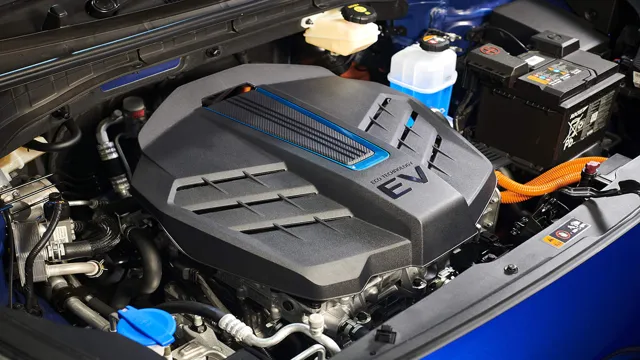Electric vehicles are taking the world by storm. From cars to buses, these eco-friendly vehicles are powered by electric engines that are proving to be incredibly efficient and cost-effective. But what exactly are electric vehicle engines, and how do they work? In this blog, we will explore the basics of electric vehicle engines and delve into the technology behind them so you can make an informed decision about your next eco-friendly vehicle.
How do EV Engines Work?
Electric vehicle (EV) engines are the power source of electric cars, and they represent a breakthrough in automotive technology. EV engines are more efficient, quieter, and easier to maintain than traditional gasoline-powered engines. An EV engine works by converting energy stored in batteries into mechanical energy that powers the car.
Batteries are charged by plugging the car into an electrical outlet or through regenerative braking. The energy stored in the batteries is then sent to an electric motor. The electric motor then converts electrical energy into mechanical energy, which is then used to power the car.
The main components of an EV engine are the battery, electric motor, and power electronics. The battery is the most important part of an EV engine, as it stores the energy that powers the car. The electric motor is responsible for converting the energy stored in the battery into mechanical energy, which is then used to turn the wheels of the car.
The power electronics control the flow of energy between the battery and the motor. EV engines are more efficient than traditional gasoline-powered engines. They do not require fuel for combustion, and they produce fewer emissions than traditional gasoline-powered engines.
Additionally, maintenance costs are lower due to the lack of moving parts. EVs are becoming increasingly popular, and many automakers are investing heavily in developing the technology. EV engines are becoming more powerful, efficient, and reliable, providing drivers with a reliable and environmentally friendly alternative to traditional gasoline-powered engines.
Advantages of Electric Vehicle Engines
Electric vehicles (EVs) are becoming increasingly popular due to their environmental benefits and cost-effectiveness. But how exactly do EV engines work? By harnessing electricity, EV engines are able to turn electrical energy into mechanical energy, which powers the vehicle. This process is much more efficient than traditional combustion engines, as it relies on electric current rather than burning fuel to create energy.
EV engines also produce fewer emissions than conventional engines, making them a great choice for those looking to reduce their environmental impact. Additionally, EV engines require less maintenance than traditional engines, making them a great long-term investment.

Disadvantages of Electric Vehicle Engines
Electric vehicle engines are becoming more popular due to their environmental benefits, but they also have a few drawbacks. While electric vehicles may be more eco-friendly than traditional combustion engines, it is important to understand how they work in order to make an educated decision. EVs rely on electric motors powered by rechargeable batteries to drive the car.
While this allows for efficient and clean operation, it also means that EVs are limited in power and range compared to combustion engines. Additionally, electric vehicle batteries require regular recharging, which can be time-consuming and inconvenient. In addition, electric vehicles are more expensive to maintain than conventional vehicles due to the complexity of the engines and batteries.
Finally, electric vehicles also produce more noise than their combustion engine counterparts, which can be disruptive for some drivers.
| Component/Aspect | Description |
|---|---|
| Electric Motor | Converts electrical energy into mechanical |
| Typically, lithium-ion batteries. | |
| Battery Pack | Stores electrical energy in chemical form. |
| Power for the electric motor. | |
| Inverter | Converts DC power from the battery to AC |
| power for the electric motor. | |
| Regenerative Braking | Captures and stores energy during braking. |
| Converts it back to electricity. | |
| Electric Powertrain | The combination of the motor, inverter, |
| Components | and other associated systems. |
| Charging Ports | Interfaces for recharging the battery pack. |
| Can be AC or DC fast chargers. | |
| Thermal Management | Systems to control and maintain the |
| Systems | temperature of the battery for efficiency. |
| Energy Management | Software algorithms to optimize power |
| Software | usage and extend battery life. |
| High Voltage Wiring | Carries electricity from the battery to |
| The motor and inverter. | |
| Vehicle Control Unit | Manages and coordinates all aspects of |
| (VCU) | the EV’s operation. |
| Cooling Systems | Ensures proper cooling of components like |
| Sources, such as solar panels. | |
| Energy Source | Electricity from the grid or renewable |
| the temperature of the battery for efficiency. |
Types of EV Engines
Electric vehicles, or EVs, are becoming increasingly popular as an alternative to traditional gasoline-powered vehicles. But how exactly do these vehicles work? Understanding the technology behind EVs is the first step to appreciating how they differ from traditional gasoline-powered cars. The heart of any electric vehicle is its engine.
EVs use electric motors instead of the traditional internal combustion engines that are found in gasoline-powered vehicles. These electric motors run off of electricity stored in a battery, eliminating the need for gasoline and other traditional fuels. Electric motors are more efficient than traditional internal combustion engines, meaning that they can convert more of the energy they use into useful power.
Additionally, electric motors can produce more torque than combustion engines, which gives EVs better acceleration. EVs also have fewer moving parts than traditional combustion engines, meaning they require less maintenance. This makes them cheaper to own and operate in the long run.
Another advantage of electric vehicles is that they produce no tailpipe emissions. This makes them a great choice for those looking to reduce their environmental impact. EVs are also quieter than traditional gasoline-powered cars, making them a great choice for those who want a quieter ride.
Finally, electric vehicles are becoming increasingly affordable. As the technology becomes cheaper and more widely available, more people are able to purchase electric vehicles. This means that electric vehicles are becoming a viable alternative to traditional gasoline-powered cars.
So, how do EV engines work? In short, they are powered by electricity stored in a battery and use electric motors instead of traditional internal combustion engines. These electric motors are more efficient, require less maintenance, and produce no tailpipe emissions, making them a great choice for those looking to reduce their environmental impact. Additionally, they are becoming increasingly affordable, making them a viable option for those in the market for a new car.
Internal Combustion Engine
The internal combustion engine (ICE) is the traditional power source for most vehicles, but the emergence of electric vehicles (EVs) has given rise to a new type of engine. So, how do EV engines work? In a nutshell, electric engines use electric motors to convert electrical energy into mechanical energy. This is achieved by using magnets to create an electromagnetic field, which, when energized, creates a force that turns the motor and ultimately propels the vehicle.
Compared to ICEs, EV engines are more efficient as they don’t generate any exhaust gases and have fewer moving parts, meaning less maintenance is required. They also generate more torque at lower RPMs, allowing for better acceleration and a smoother ride. All in all, EV engines are a far more reliable and efficient alternative to the ICE.
Hybrid Electric Vehicle Engine
Hybrid electric vehicles (EVs) are rapidly becoming an increasingly popular choice for drivers looking for a reliable and eco-friendly transportation option. But how exactly do EV engines work? By combining a traditional combustion engine with an electric motor, EVs are able to deliver improved fuel efficiency, reduced emissions, and a smoother and quieter ride. The combustion engine is responsible for providing the power needed to move the vehicle. At the same time, the electric motor acts as a ‘boost’ that helps the vehicle accelerate faster and respond quicker to changes in speed.
The battery pack is used to store energy that is generated from the combustion engine, which is then used to power the electric motor when the driver needs to accelerate. This combination of an electric motor and a combustion engine allows EVs to offer a driving experience that is both efficient and enjoyable.

Battery Electric Vehicle Engine
The battery electric vehicle (BEV) engine is one of the most efficient and cleanest kinds of engines out there. It works by using an electric motor powered by a rechargeable battery pack to turn the wheels of the car. This battery pack is usually made of lithium-ion cells, which store the energy produced by the motor and can be recharged using a variety of sources, such as wall outlets or solar power.
The electric motor itself is highly efficient, producing less heat and noise than traditional combustion engines while also creating no emissions. This makes BEV engines an attractive option for those looking to reduce their environmental footprint while still getting around efficiently and reliably.
Frequently Asked Questions [FAQs]
How does an electric vehicle engine work?
An electric vehicle engine works by converting energy stored in batteries into mechanical energy that is used to power the car. The batteries are charged by plugging the car into an electrical outlet or through regenerative braking. The energy stored in the batteries is then sent to an electric motor, which converts the electrical energy into mechanical energy to turn the wheels of the car.
What are the advantages of electric vehicle engines?
Electric vehicle engines have several advantages over traditional combustion engines. They are more efficient, produce fewer emissions, and require less maintenance. They also provide better acceleration and a smoother ride due to the high torque produced by electric motors. In addition, electric vehicles are quieter and can help reduce our carbon footprint and protect the environment.
What are the disadvantages of electric vehicle engines?
While electric vehicle engines have many advantages, they also have a few drawbacks. Electric vehicles have limited power and range compared to combustion engines, and their batteries require regular recharging, which can be time-consuming. Electric vehicles are also more expensive to maintain due to the complexity of the engines and batteries. Finally, electric vehicles produce more noise than traditional combustion engines.
What types of electric vehicle engines exist?
There are several types of electric vehicle engines; engines can be recharged using renewable energy sources such as solar power or wind power. This makes electric vehicles even more environmentally friendly since they can be powered by clean, renewable energy. By using renewable energy to charge electric vehicle batteries, we can further reduce greenhouse gas emissions and dependence on fossil fuels.
How long does it take to recharge an electric vehicle battery?
The time it takes to recharge an electric vehicle battery depends on several factors. The size of the battery and the charging speed of the charging station or outlet can affect the charging time. On average, it can take anywhere from 30 minutes to several hours to fully recharge an electric vehicle battery. However, fast-charging stations are becoming more widely available, which can significantly reduce charging times.
Conclusion
EV engines work by harnessing the power of electricity to drive an electric motor, creating a clean and efficient form of transportation. EV engines are the future – they are an environmentally friendly alternative to traditional combustion engines that can help reduce our carbon footprint and protect our planet. So, the next time you’re looking for a new mode of transportation, consider an EV engine and help make the world a better place.

I am James Beaupre, the founder of batteryvehicleprice.com. With a deep-rooted passion for vehicle batteries, I have dedicated my career to exploring and understanding the intricacies of this crucial technology. My website aims to provide valuable insights and information on battery-powered vehicles, empowering individuals to make informed decisions.
